Gameplay:
You control Hotsuma with the left analog stick, and can control the camera angle with the right. The bottom most button in the four button diamond (I can never remember what friggin nonsensical shape Sony put where on the DualShock, and I don't feel like going out to look at the controller) allows you to do a very quick speed dash, that leaves a ghost image of yourself where you were when you pressed the button, and allows you to dash in any direction, or even in circles around enemies if you've locked onto them. If you dash behind an enemy, you will do more damage, and usually kill them in one hit.
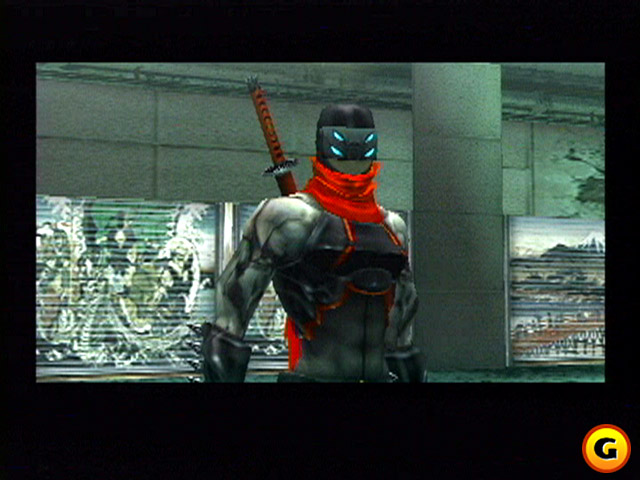 You lock on using the R1 button to lock to the nearest enemy, and R2 to cycle
through the enemies. The options screen has an option to change the controls
so that when you hit R1 it leaves on the lock until you press R1 again. While
this causes as many beginner issues as having to hold R1 does, I prefer it to
stay locked and automatically switch to the next opponent unless I hit R1 again.
You lock on using the R1 button to lock to the nearest enemy, and R2 to cycle
through the enemies. The options screen has an option to change the controls
so that when you hit R1 it leaves on the lock until you press R1 again. While
this causes as many beginner issues as having to hold R1 does, I prefer it to
stay locked and automatically switch to the next opponent unless I hit R1 again.
The right button in the diamond is the jump button. At any time in a jump you can do a speed dash with the bottom button, or a flip that is basically a double jump. The double jump, unlike previous Shinobi games, can be done at any time while in the air, even if you only walked off, or got knocked off a level, it does not have to be done at the height of the jump.
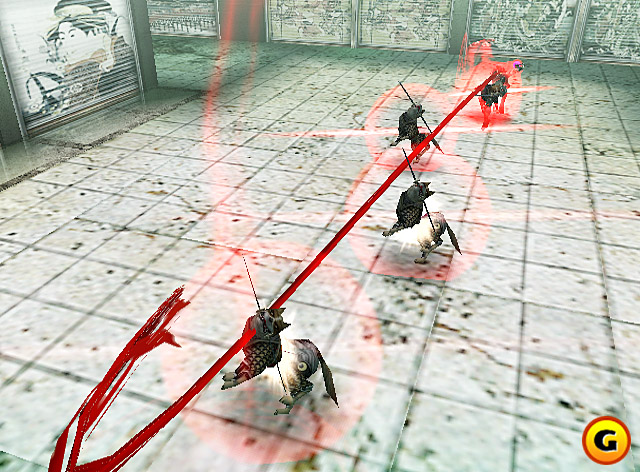 The left button in the diamond is your sword attack, which is pretty straight
forward, though you do have at least a couple combos, a 360 degree circular
strike that will knock several enemies down and away from you if you are holding
forward while locked on, and a guard breaking kick if you are holding back while
locked on.
The left button in the diamond is your sword attack, which is pretty straight
forward, though you do have at least a couple combos, a 360 degree circular
strike that will knock several enemies down and away from you if you are holding
forward while locked on, and a guard breaking kick if you are holding back while
locked on. Once your sword awakens, and starts desiring souls, you have a second energy bar that signifies how "full" the sword is. You can use the energy in this bar for a special, straight line, attack that can take out any enemies in your way if you do it correctly( or send you flying off a roof), but if you miss you'll find your own energy bar being eaten by the sword for not getting the souls in time.
Tate:
Tate is the core of Shinobi's gameplay. A Tate is when you kill every opponent in the immediate area, which are represented by orbs on the top of the screen. As you cut through them, you have about three or four seconds to kill the next one in the group, or all of the enemies you've killed will die, and your chance to tate that group is over.
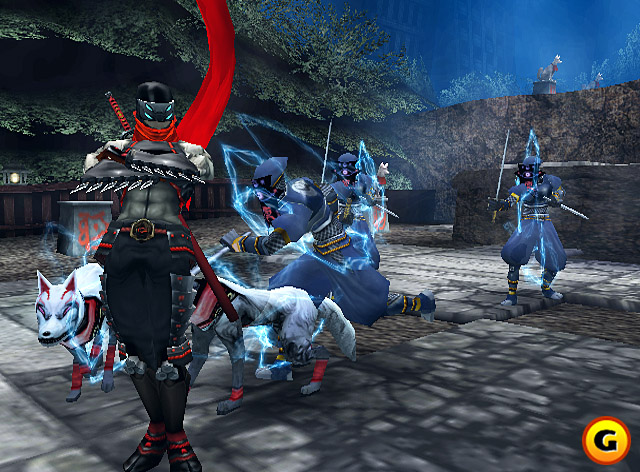 For performing a Tate, rather than just killing each enemy one by one, you get
rewarded two fold. First, while you are working up to the Tate, your attacks
become much more powerful. At the end of a six to eight enemy tate you can take
down an enemy that would normally take ten hits, with one hit. You can also
kill bosses in one or two hits if you can kill six to eight enemies and get
to the boss in those short seconds to hit him. Then, once the tate is complete,
you get more sword energy, and if any of the enemies (usually just the extra
large ones) were going to give you any life bar energy, they'll give a few more
of those too.
For performing a Tate, rather than just killing each enemy one by one, you get
rewarded two fold. First, while you are working up to the Tate, your attacks
become much more powerful. At the end of a six to eight enemy tate you can take
down an enemy that would normally take ten hits, with one hit. You can also
kill bosses in one or two hits if you can kill six to eight enemies and get
to the boss in those short seconds to hit him. Then, once the tate is complete,
you get more sword energy, and if any of the enemies (usually just the extra
large ones) were going to give you any life bar energy, they'll give a few more
of those too. The air tate is possibly equally important to completing the game. If you are locked on to an opponent, you can do your speed dash while in the air and it will bring you to the opponent, then if you can hit the opponent at least once with your sword, you can speed dash again. If the opponent dies, and you still have lock on you can immediately air dash to the next opponent, whom you then have to hit at least once before air dashing again. If, at any time, you miss an opponent, get hit by a projectile, or try to air dash to an opponent that is out of reach, you fall straight down. Conserving your double jump until after you've finished your air tate is usually a good idea. There's more to the gameplay, but that's the bulk of it. This game really has to be played, all the way through, to be fully understood.
Review comments:
Electronic Gaming Monthly claimed that the level designs somehow didn't let the gameplay play out fully.
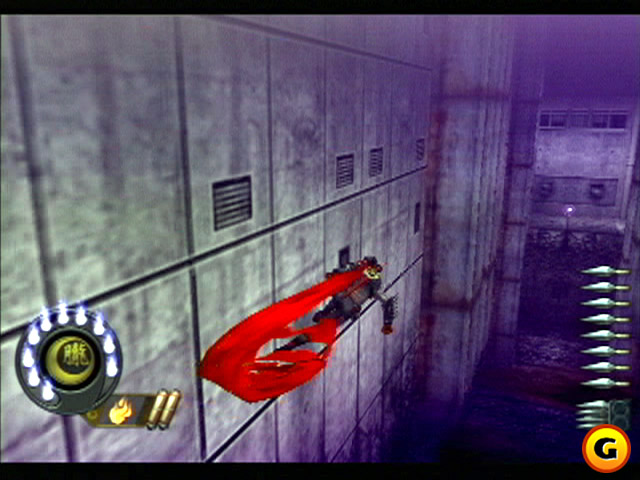 This is absolute garbage. The level designs make
you use every aspect of Hotsuma's abilities, just to survive them.
This is absolute garbage. The level designs make
you use every aspect of Hotsuma's abilities, just to survive them. You don't get to wall run in Shinobi, there are entire levels where you wall run because there is no ground to run on, and if you fall, it means starting the entire level over. The levels are designed very well to force you to use the gameplay, most of them just don't look very pretty due to the color scheme and the blurry textures.
I suspect that most of the game mag reviewers didn't actually finish the game before they reviewed it. Since the difficulty level subsides once the game teaches you how to play through the level designs, casting judgement too early, on something as subjective as whether the game is "fun" or not, would cause somebody to complain about the levels and the difficulty.
Difficulty:
The difficulty in learning how to play this game will be a big deterrent for people who are looking to relax, or who want an easy exploration quest. Shinobi is not hard due to deliberately difficult gameplay elements however. It's only hard at first, or the first time through the game, while you're still learning how to play correctly. Once you've gotten to later levels, you'll have only yourself to blame for dieing.
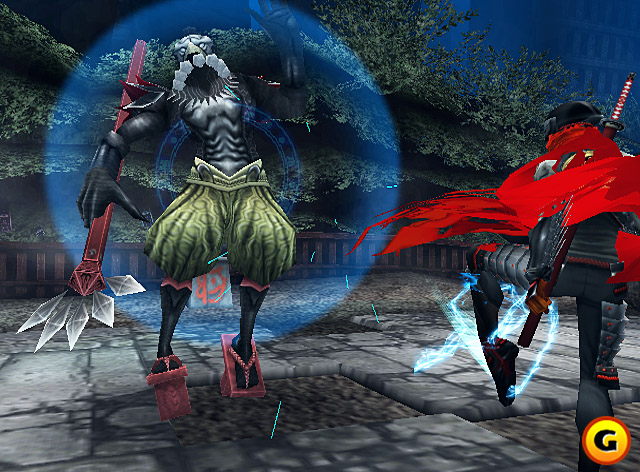 The only reason I lose in this game is because I tried something a little too
fancy, or messed up an air tate. The game doesn't overwhelm you with attacks,
and I don't think its jumps are as hard as some in Revenge of Shinobi or its
fighting is as difficult as Shadow Dancer's where you died in one hit. You also
don't have a set number of retries before you have to start the whole game over.
It saves at the end of each level, and you can retry that level an infinite
number of times.
The only reason I lose in this game is because I tried something a little too
fancy, or messed up an air tate. The game doesn't overwhelm you with attacks,
and I don't think its jumps are as hard as some in Revenge of Shinobi or its
fighting is as difficult as Shadow Dancer's where you died in one hit. You also
don't have a set number of retries before you have to start the whole game over.
It saves at the end of each level, and you can retry that level an infinite
number of times.This Shinobi just requires some serious platforming skills to develop, because there really isn't another 3D game out there that plays like it. There are jumps that require you to run and jump from the very edge of a platform, double jump at the right time, and then air dash to clear the distance. These jumps are actually one of the easier aspects of completing the game's levels though, they aren't so far away that you have to hit the double jump at just the right instant, and then dash at the right instant, as some of the jumps in the earlier games were.
Again, the thing that kills me the most in this game is a messed up air tate. Nearly every air tate opportunity occurs up in the air above a bottomless pit. I've had two problems with air tate. The biggest one is that I get too tense, and fat finger the dash and jump button, or miss the attack button when I have that one instant to land an attack so I can dash again. If I hit the right buttons at the right times, it would be extremely easy in most cases.
The second problem I've had is that not all groups of enemies are arranged for an air tate. A lot of times you have to turn off lock on, get clear to a wall, and wall run to the next enemy to continue the tate, and if you try to air dash to that enemy while locked on, you just won't make it. It was kind of annoying to me at first that they weren't all lined up for me, but then I started practicing attacking without lock on, and found a whole new challenge to the gameplay, and discovered just how fine tuned this game really is.
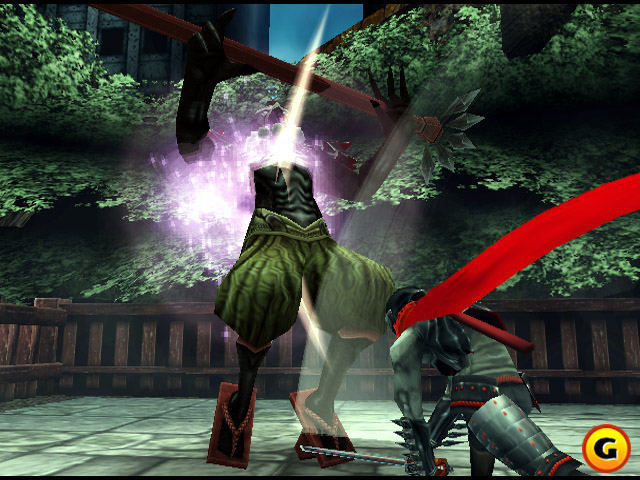 Much of the game can be completed much faster if you don't rely on the lock
on. Which would be why the default lock on setting is set to make you hold the
R1 button down to lock on. Lock on should be used to find the nearest enemy
quickly, but should not be relied on to tell you who to attack next.
Much of the game can be completed much faster if you don't rely on the lock
on. Which would be why the default lock on setting is set to make you hold the
R1 button down to lock on. Lock on should be used to find the nearest enemy
quickly, but should not be relied on to tell you who to attack next. Sometimes the nearest enemy is the biggest and strongest, and you should attack the smaller flying enemies first so you can kill the big one in one hit.
Boss Fights:
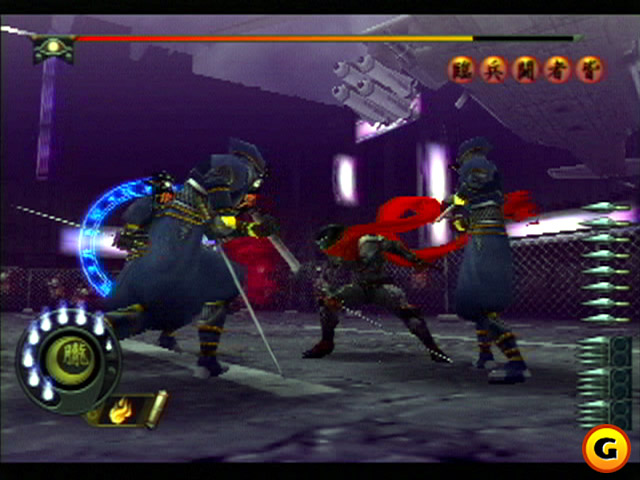 The boss fights are what really make this game something special. You'll fight
enemies that are just as skilled and fast as you are in this game, in its boss
fights.
The boss fights are what really make this game something special. You'll fight
enemies that are just as skilled and fast as you are in this game, in its boss
fights. You'll also fight giant six armed behemoths that use ninja magic and have six to eight projectile throwing heads flying around at all times, and you have to jump to your full height just to hit his weak spot.
You'll fight an enemy that sends about ten dogs after you, that run around you in circles if you lock onto them, while the others attack you from all angles. The boss fights in this game aren't at the end of a level, most of them are a level of their own.
The fights that I really think take the cake are the later ones with the most skilled members of your clan. The first time I realized I was getting my butt handed to me, only because I was making too much noise in the ankle high water I was in, and that my opponent was actually blind, all of the frustration of the game melted away. I knew that I had another excellent Shinobi in my library.
Conclusion:
Shinobi is probably one of those games that had its entire development time spent on making the gameplay mechanics work like a Sega game should. My only real complaint is the almost complete lack of eye candy in the game, though it does look well above average for a PS2 game and runs at 60FPS.
Also, the music, while actually very good, doesn't rock like the 16-bit games, or the Sonic Adventure games do in my opinion. At least, I haven't found myself with any of the game's BGM stuck in my head like I have Sonic Adventure 1+2 or Yuzo Koshiro's stuff in Revenge of Shinobi and Shadow Dancer.
Shinobi is a very well made and unique game in its own right. It's a game that should have received higher marks in the game mags for technical achievements and gameplay refinement alone. If what you're looking for is a unique action game, with refined and original gameplay, then you ought to give Shinobi at least one full play through.